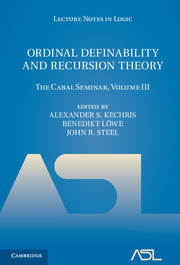Book contents
- Frontmatter
- Contents
- Preface
- Original Numbering
- PART V HOD AND ITS LOCAL VERSIONS
- PART VI RECURSION THEORY
- Recursion theoretic papers. Introduction to Part VI
- On recursion in E and semi-Spector classes
- On Spector classes
- Trees and degrees
- Definable functions on degrees
- Π12 monotone inductive definitions
- Martin's conjecture, arithmetic equivalence, and countable Borel equivalence relations
- Bibliography
- References
Martin's conjecture, arithmetic equivalence, and countable Borel equivalence relations
from PART VI - RECURSION THEORY
Published online by Cambridge University Press: 05 December 2015
- Frontmatter
- Contents
- Preface
- Original Numbering
- PART V HOD AND ITS LOCAL VERSIONS
- PART VI RECURSION THEORY
- Recursion theoretic papers. Introduction to Part VI
- On recursion in E and semi-Spector classes
- On Spector classes
- Trees and degrees
- Definable functions on degrees
- Π12 monotone inductive definitions
- Martin's conjecture, arithmetic equivalence, and countable Borel equivalence relations
- Bibliography
- References
Summary
Introduction. There is a fascinating interplay and overlap between recursion theory and descriptive set theory. A particularly beautiful source of such interaction has been Martin's conjecture on Turing invariant functions. This longstanding open problem in recursion theory has connected to many problems in descriptive set theory, particularly in the theory of countable Borel equivalence relations.
In this paper, we shall give an overview of some work that has been done on Martin's conjecture, and applications that it has had in descriptive set theory. We will present a long unpublished result of Slaman and Steel that arithmetic equivalence is a universal countable Borel equivalence relation. This theorem has interesting corollaries for the theory of universal countable Borel equivalence relations in general. We end with some open problems, and directions for future research.
Martin's conjecture. Martin's conjecture on Turing invariant functions is one of the oldest and deepest open problems on the global structure of the Turing degrees. Inspired by Sacks’ question on the existence of a degree-invariant solution to Post's problem [Sac66], Martin made a sweeping conjecture that says in essence, the only nontrivial definable Turing invariant functions are the Turing jump and its iterates through the transfinite.
Our basic references for descriptive set theory and effective descriptive set theory are the books of Kechris [Kec95] and Sacks [Sac90]. Let ≤T be Turing reducibility on the Cantor space ω2, and let ≡T be Turing equivalence. Given x ∈ω2, let x′ be the Turing jump of x. The Turing degree of a real x∈ω2 is the ≡T equivalence class of x. A Turing invariant function is a function such that for all reals x, y ∈ ω2, if x ≡T y, then f(x) ≡T f(y). The Turing invariant functions are those which induce functions on the Turing degrees.
With the axiom of choice, we can construct many pathological Turing invariant functions. Martin's conjecture is set in the context of ZF+DC+AD, where AD is the axiom of determinacy. We assume ZF+DC+AD for the rest of this section. The results we will discuss all “localize” so that the assumption of AD essentially amounts to studying definable functions assuming definable determinacy, for instance, Borel functions using Borel determinacy.
Information
- Type
- Chapter
- Information
- Ordinal Definability and Recursion TheoryThe Cabal Seminar, Volume III, pp. 493 - 520Publisher: Cambridge University PressPrint publication year: 2016
References
Accessibility standard: Unknown
Why this information is here
This section outlines the accessibility features of this content - including support for screen readers, full keyboard navigation and high-contrast display options. This may not be relevant for you.Accessibility Information
- 7
- Cited by
